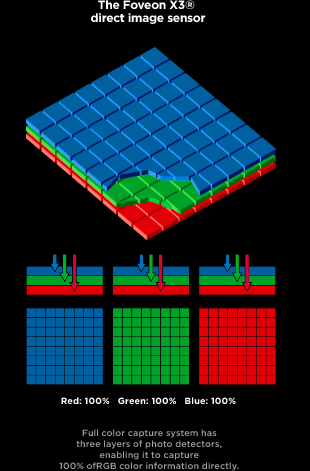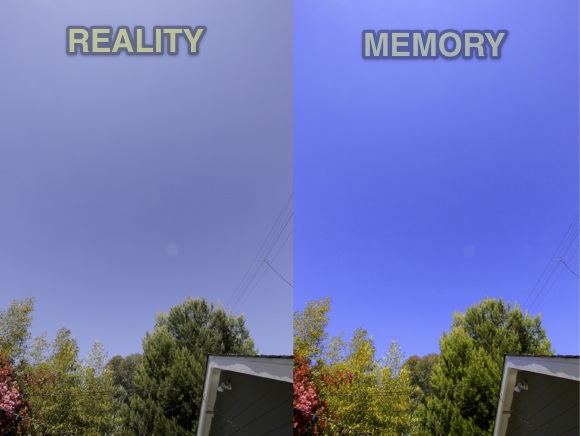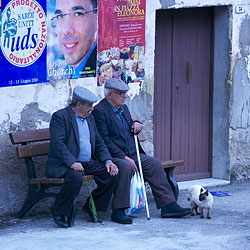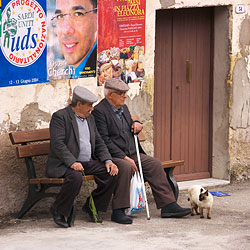It looks like you're using an Ad Blocker.
Please white-list or disable AboveTopSecret.com in your ad-blocking tool.
Thank you.
Some features of ATS will be disabled while you continue to use an ad-blocker.
share:
reply to post by Uncinus
From your own link regarding the photos,
"He used a specialized camera to capture three black and white images"
Regards, Iwinder
From your own link regarding the photos,
"He used a specialized camera to capture three black and white images"
Regards, Iwinder
Originally posted by Uncinus
They are not black and white. They are color. Very accurate color.
All digital images are made up from three monochrome images that make up what you see as the final color image. This is no different.
You are both partially correct. They are monochrome one color which looks black and white... by shining the right color light they could get a color image...
ibed wiki above.
His process used a camera that took a series of three monochrome pictures in sequence, each through a different-colored filter. By projecting all three monochrome pictures using correctly colored light, it was possible to reconstruct the original color scene
My huge Sony rear projection Television shines 3 colored lights to get the color on the screen too.
There are a variety of ways a modern camera sensor takes pictures but they mostly use a one step process.
But that is totally off topic.
Regardless no one denies there are naturally milky days naturally.
You seem to deny that modern contrails are affecting our skies.
Which is down right silly.
edit on 27-3-2012 by pianopraze because: typos
reply to post by pianopraze
Thanks I needed that slap in the face, I was really getting off topic and I apologize for that.
My emotions get the better of me at times and they need a good check once in awhile here.
Back to topic here now I promise.
Regards, Iwinder
Thanks I needed that slap in the face, I was really getting off topic and I apologize for that.
My emotions get the better of me at times and they need a good check once in awhile here.
Back to topic here now I promise.
Regards, Iwinder
Originally posted by Iwinder
reply to post by Uncinus
From your own link regarding the photos,
"He used a specialized camera to capture three black and white images"
Regards, Iwinder
You understand that all digital cameras also work by taking three black and white images with color filters, right?
en.wikipedia.org...
So you want to ban anyone who posts a digital photo and claims it's color?
reply to post by pianopraze
There is a "reason" why (the) discussions on Boards such as "ATS" tend to flounder....
....it is because of the "nature" of the Interet.
Sadly, it seems, it is the "other" nature of some (not particularly "this" OP) ....but, others (sadly) all to often, it's the "Same ole, Same ole...:
Too often, and WAY "too" repetitive....
Shame.
There is a "reason" why (the) discussions on Boards such as "ATS" tend to flounder....
....it is because of the "nature" of the Interet.
Sadly, it seems, it is the "other" nature of some (not particularly "this" OP) ....but, others (sadly) all to often, it's the "Same ole, Same ole...:
Too often, and WAY "too" repetitive....
Shame.
Originally posted by pianopraze
Regardless no one denies there are naturally milky days naturally.
I've heard people deny this. They will call a day like today in Los Angeles "artificial", as the sky is a bit hazy, and they claim it was deep blue when they were a child. But I noticed no persistent contrails today.
You seem to deny that modern contrails are affecting our skies.
Contrails are clouds, sometimes they spread out to cover the sky, they create more cloud cover. They decrease the day/night temperature range.
But the skies have not "changed", in the way they might change if we were geoengineering, or if there was a large volcanic eruption. That's what people think - that the skies are always milky because they are full of aluminum oxide or sulfates. But they are not. They are just cloudy (with high altitude clouds) more often.
edit on 27-3-2012 by Uncinus because: (no reason given)
Originally posted by Uncinus
You understand that all digital cameras also work by taking three black and white images with color filters, right?

You are not correct. But again this is off topic.
Sigma SD1
All pixels capture full RGB color
This means that a direct image sensor having 15,000,000 pixel locations is able to capture full red, green and blue color information, as is, at each pixel location. In other words, all 15,000,000 pixel locations can respond to all three primary RGB colors transmitted by the lens.
There is no need to assign red, green and blue to separate pixel locations, nor is it necessary to fabricate or eliminate color information during image processing.
So quit picking on him and get back on topic...
Originally posted by Uncinus
I've heard people deny this. They will call a day like today in Los Angeles "artificial", as the sky is a bit hazy, and they claim it was deep blue when they were a child.
Contrails are clouds, sometimes they spread out to cover the sky, they create more cloud cover. They decrease the day/night temperature range.
But the skies have not "changed", in the way they might change if we were geoengineering, or if there was a large volcanic eruption. That's what people think - that the skies are always milky because they are full of aluminum oxide or sulfates. But they are not. They are just cloudy (with high altitude clouds) more often.
They claim it because the skies were different when we were younger.
These contrails are unintended geoengineering, people do not know how much, but there is an attempt to find out... 9/11 showed this.
The skies HAVE changed.
How can you claim otherwise?
edit on 27-3-2012 by pianopraze because: (no reason given)
reply to post by Iwinder
The 100 year old photo is probably a more realistic rendition of was there at the time than today's cameras that can (and do by default) apply preset amounts of colour saturation and contrast enhacement.If you were to set any modern point and shoot camera to all in-camera enhancements on flat you'd get a less pleasing to look at but more accurate photographic image.This is done because unlike pro photographers who like to mess about with the images in Photoshop afterwards to get the best results,snappers with point-and-shoot cameras like to take photos that they can look at straight away without any sort of manipulation and most importantly they want richly saturated colours.How many photos have you seen advertising cameras/colour printers/lenses that show a photo of a bright red fire engine on a sunny day with deep blue sky and green grass?
The point of all this is to prove that the photos taken 100 years ago showing landscape and sky amongst other things are less likely to have been manipulated than any modern photos.The sky in Russia in 1910 looked to be exactly the same colour and have the same amount of haze closer to the ground as we've been seeing in the UK for the last 3 or 4 days and and is forecast again right into the weekend.
The 100 year old photo is probably a more realistic rendition of was there at the time than today's cameras that can (and do by default) apply preset amounts of colour saturation and contrast enhacement.If you were to set any modern point and shoot camera to all in-camera enhancements on flat you'd get a less pleasing to look at but more accurate photographic image.This is done because unlike pro photographers who like to mess about with the images in Photoshop afterwards to get the best results,snappers with point-and-shoot cameras like to take photos that they can look at straight away without any sort of manipulation and most importantly they want richly saturated colours.How many photos have you seen advertising cameras/colour printers/lenses that show a photo of a bright red fire engine on a sunny day with deep blue sky and green grass?
The point of all this is to prove that the photos taken 100 years ago showing landscape and sky amongst other things are less likely to have been manipulated than any modern photos.The sky in Russia in 1910 looked to be exactly the same colour and have the same amount of haze closer to the ground as we've been seeing in the UK for the last 3 or 4 days and and is forecast again right into the weekend.
Anyways I hate to repeat myself but I will here.....When is the last time anyone has seen a deep blue sky and I mean deep blue?
I will not be baited anymore here and I will stick to the issue at hand here..... Namely the night pictures of the suspicious jet trails spreading out.
Heck I won't even mention the sun either.
Regards, Iwinder
I will not be baited anymore here and I will stick to the issue at hand here..... Namely the night pictures of the suspicious jet trails spreading out.
Heck I won't even mention the sun either.
Regards, Iwinder
Originally posted by pianopraze
Originally posted by Uncinus
You understand that all digital cameras also work by taking three black and white images with color filters, right?

You are not correct. But again this is off topic.
Sigma SD1
All pixels capture full RGB color
This means that a direct image sensor having 15,000,000 pixel locations is able to capture full red, green and blue color information, as is, at each pixel location. In other words, all 15,000,000 pixel locations can respond to all three primary RGB colors transmitted by the lens.
There is no need to assign red, green and blue to separate pixel locations, nor is it necessary to fabricate or eliminate color information during image processing.
That's rather nit-picking. It still produces three black and white images. It's still filtering the light, just in a vertical manner that allows greater pixel density.
reply to post by Iwinder
In terms of what I recall....???
See it every day when the sky is free of natural clouds. I live in SoCal.....we have FAR too many days as you describe.....come, and move here....feel the "joy"!!
The (as I infer) claims of "grayish skies" are truly over-stated.
Hey!!! Why not re-locate to somewhere on some island in the Pacific Ocean?? And, then report back to "us" about "azure skies".....OK??????
When is the last time anyone has seen a deep blue sky and I mean deep blue?
In terms of what I recall....???
See it every day when the sky is free of natural clouds. I live in SoCal.....we have FAR too many days as you describe.....come, and move here....feel the "joy"!!
The (as I infer) claims of "grayish skies" are truly over-stated.
Hey!!! Why not re-locate to somewhere on some island in the Pacific Ocean?? And, then report back to "us" about "azure skies".....OK??????
edit on Tue 27 March 2012 by ProudBird because: (no reason given)
Originally posted by pianopraze
They claim it because the skies were different when we were younger.
These contrails are unintended geoengineering, people do not know how much, but there is an attempt to find out... 9/11 showed this.
The skies HAVE changed.
How can you claim otherwise?
I'm being quite specific in what I claim - that there is more high altitude aviation-induced cirrus cloud on days when contrails form. I don't consider this the sky changing, because the next day when no contrails form, then the sky is back to normal.
Other people claim that there's a semi-permanent visible change in the sky that they can see every day, regardless of if contrails form. I see no evidence for this.
What are you claiming?
reply to post by ProudBird
You have to have a care about which island you pick.
www.funhawaiitravel.com...
You have to have a care about which island you pick.
www.funhawaiitravel.com...
Originally posted by Imagewerx
reply to post by Iwinder
The 100 year old photo is probably a more realistic rendition of was there at the time than today's cameras that can (and do by default) apply preset amounts of colour saturation and contrast enhacement.If you were to set any modern point and shoot camera to all in-camera enhancements on flat you'd get a less pleasing to look at but more accurate photographic image.This is done because unlike pro photographers who like to mess about with the images in Photoshop afterwards to get the best results,snappers with point-and-shoot cameras like to take photos that they can look at straight away without any sort of manipulation and most importantly they want richly saturated colours.How many photos have you seen advertising cameras/colour printers/lenses that show a photo of a bright red fire engine on a sunny day with deep blue sky and green grass?
The point of all this is to prove that the photos taken 100 years ago showing landscape and sky amongst other things are less likely to have been manipulated than any modern photos.The sky in Russia in 1910 looked to be exactly the same colour and have the same amount of haze closer to the ground as we've been seeing in the UK for the last 3 or 4 days and and is forecast again right into the weekend.
Not very likely. Because photo stock deteriorates. The light they are shining through these are a guess at best.. and through deteriorated media.
Modern cameras can accurately reproduce current conditions. Photographers avoid much of the day light due to color temperature, use filters, and shoot in morning/evening to get light that looks more artistic.
One of the common benchmarks for cameras is accurate color reproduction.
here is the benchmark for mine, with a quick comparison of cameras of our choice:
DP review
Modern cameras are extremely accurate.
edit on 27-3-2012 by pianopraze because: typos
reply to post by Uncinus
I was out today, in SoCal (Southern California) and noted, this afternoon, the continued high cirrus, and a few fracto alto-cumulus, and a few alto-cirrus clouds.....ALL as the after-effects of the rains that we had (over the weekend....today is TUESDAY 27th March, 2012)......During the few days prior, in the Los Angeles area (West Coast region) we had some rain...a LOT of rain.
The facts of the clouds, and the meteorological information, are clear for all to see.....
I was out today, in SoCal (Southern California) and noted, this afternoon, the continued high cirrus, and a few fracto alto-cumulus, and a few alto-cirrus clouds.....ALL as the after-effects of the rains that we had (over the weekend....today is TUESDAY 27th March, 2012)......During the few days prior, in the Los Angeles area (West Coast region) we had some rain...a LOT of rain.
The facts of the clouds, and the meteorological information, are clear for all to see.....
Originally posted by pianopraze
Modern cameras can accurately reproduce current conditions.
Actually I think that the accuracy of modern cameras is in part to blame for the propagation of this idea that the sky has changed.
There's a thing called "memory colors", which is the color by which you remember a particular thing. If given a set of color chips, you can pick out one that most closely matches the memory of a thing. That's the memory color. In most cases the memory color is more saturated than the real color. Of as the researchers put it:
www.opticsinfobase.org...
Each memory color tended to be more characteristic of the dominant chromatic attribute of the object in question; grass was more green, bricks more red, etc. In most cases, saturation and lightness increased in memory.
In photography, memory colors are the particular colors of familiar items that people remember as being more vibrant than they actually were - particularly blue sky, green foliage, and skin tones. The actual intensity of the memory colors varies based on where you grew up, and what colors you were exposed to. Remember though, the memory colors are not the actual colors, but your more saturated recollection of them.
Some cameras have a mode that takes advantage of this, and boosts the blues and greens and skin tones, to produce a more "realistic" photo. This actually approximates the old saturated color of film cameras, and our color memories. But it's not accurate.
This photo was taken with my Canon 7D, a very nice modern camera, capable of very accurate color reproduction. The image on the left is raw from the camera, and is what was really there. But the image on the right (Saturation +50) seems much closer to how I remember it. It matches my color memory.

reply to post by Uncinus
Well, as with all things there are points that need clarification. Yes they can produce very accurate colors BUT...
... they need to be white balanced.
That first image you show looks incorrectly white balanced to me.
incorrect white balance ....................... correct white balance


And as to that other load of poop your trying to sell... forget it.
Your flat out trying to say the skies are no different today than they were years ago.
...and that is a sack of poop.
Again it seems like you all are relying on this mechanism. I trust my own senses not your BS:
Well, as with all things there are points that need clarification. Yes they can produce very accurate colors BUT...
... they need to be white balanced.
That first image you show looks incorrectly white balanced to me.
incorrect white balance ....................... correct white balance


And as to that other load of poop your trying to sell... forget it.
Your flat out trying to say the skies are no different today than they were years ago.
...and that is a sack of poop.
Again it seems like you all are relying on this mechanism. I trust my own senses not your BS:
edit on 27-3-2012 by pianopraze because: ....
edit on 27-3-2012 by pianopraze because: added link to photo reference and white
balance information
chemtrails are actually making the sky bluer according to some believers.
Hey don't blame me y'all can't get the story straight!
Hey don't blame me y'all can't get the story straight!
The color of the sky changes all day everyday. The reason the sky is blue in the first place is because the sunlight is scattered by our atmosphere.
The refraction of sunlight caused by our atmosphere will vary depending on the angle of the Sun to the horizon.
The sky will usually be it's bluest when the sun is directly overhead. 12 -2 pm. The thickness of the atmosphere, aerosol content and other factors like humidity will affect the color of the sky.
There is no doubt that people in populated areas that have high levels of air pollution and air traffic will have the color of their skies affected by these factors.
More planes = more pollution = change in color
The sky will usually be it's bluest when the sun is directly overhead. 12 -2 pm. The thickness of the atmosphere, aerosol content and other factors like humidity will affect the color of the sky.
There is no doubt that people in populated areas that have high levels of air pollution and air traffic will have the color of their skies affected by these factors.
More planes = more pollution = change in color
reply to post by Uncinus
Funny you should mention rain, haven't had a drop in at least 2 months, possibly 3.
We did have a massive bush fire about a month ago where we were stuck with smoke lingering at ground level for nearly two weeks. Most of that would have been blown away by now though.
Funny you should mention rain, haven't had a drop in at least 2 months, possibly 3.
We did have a massive bush fire about a month ago where we were stuck with smoke lingering at ground level for nearly two weeks. Most of that would have been blown away by now though.
new topics
-
New Disney Star Wars Films Failing Test of Time?
Movies: 6 hours ago -
The Cost of True Discipleship—Count the Cost
Religion, Faith, And Theology: 11 hours ago
top topics
-
Mass UAP events. DC. Machester Airport, UFOs over sub base in CT, Nuke bases.
Aliens and UFOs: 13 hours ago, 13 flags -
Thanking a rosemary plant
General Chit Chat: 17 hours ago, 6 flags -
population madness
New World Order: 13 hours ago, 4 flags -
New Disney Star Wars Films Failing Test of Time?
Movies: 6 hours ago, 2 flags -
The Cost of True Discipleship—Count the Cost
Religion, Faith, And Theology: 11 hours ago, 1 flags
active topics
-
Mass UAP events. DC. Machester Airport, UFOs over sub base in CT, Nuke bases.
Aliens and UFOs • 17 • : tjack -
-@TH3WH17ERABB17- -Q- ---TIME TO SHOW THE WORLD--- -Part- --44--
Dissecting Disinformation • 3413 • : Thoughtful3 -
Results of the use of the Oreshnik missile system in Dnepropetrovsk
World War Three • 252 • : Oldcarpy2 -
population madness
New World Order • 18 • : KnowItAllKnowNothin -
New Disney Star Wars Films Failing Test of Time?
Movies • 9 • : BingoMcGoof -
The Cost of True Discipleship—Count the Cost
Religion, Faith, And Theology • 4 • : FullHeathen -
Holy Cow! Erm...Six Legged Turkey!!
World Sports • 10 • : Flyingclaydisk -
Unidentified Flying Objects Over U.S. Military Bases in Northeast UK, as of roughly 11 a.m. CST.
Aliens and UFOs • 29 • : BeyondKnowledge3 -
Why isn't Psychiatry involved?
Social Issues and Civil Unrest • 19 • : lilzazz -
Post A Funny (T&C Friendly) Pic Part IV: The LOL awakens!
General Chit Chat • 7849 • : underpass61
